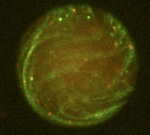
The cytoskeleton of cells constitutes one canonical system forming dynamic organizations when interacting with molecular motors. These materials constitute a state of active matter that exhibit out-of-equilibrium behavior with oriented order in the presence of energy. However, such active materials are highly dependent on the intrinsic properties of their constituents (fibers, molecular motors, and energy), which makes it difficult to control their behavior. Being able to manipulate directly the constitutive elements of the active gel could provide additional control parameters. Here, we report a strategy to functionalize and manipulate active microtubule-based structures upon magnetic actuation. We engineered protein nanocage ferritins as magnetic labels targeting molecular motors (Eg5 kinesin motors). We first mixed these magnetic motors with individual microtubules, allowing for their manipulation. In order to generate a magnetic-responsive gel, we then mixed the magnetic motors with active microtubule-based structures and characterized their dynamic behavior. We found that the magnetic forces applied on magnetic motors slowed down the dynamics of the microtubule structures as well as constrained their rotation. Our results highlight how genetically encoded magnetic elements, behaving as magnetic actuators, could perturb active gels.

References:
Self-Assembly of Magnetically-Functionalized Molecular Motors and Microtubules into Active Gels
Wang WA, Garcia-Jove Navarro M, and Gueroui Z.
Soft Matter, 2019, 15, 9111 – 9119.
DOI: 10.1039/C9SM01227C
